HOW TO FIND THREE DIFFERENT REPRESENTATIONS OF A POLAR POINT
Subscribe to our ▶️ YouTube channel 🔴 for the latest videos, updates, and tips.
Subscribe to our ▶️ YouTube channel 🔴 for the latest videos, updates, and tips.
Every point can be represented by infinitely many pairs of polar coordinates. This happens because any angle in standard position is co-terminal with infinitely many other angles.
If the point P has polar coordinates (r, θ), then P also be represented by polar coordinates
(r, θ + 2kπ) or (-r, θ + (2k+1) π)
where k is any integer.
Find all pairs of polar coordinates that describe the same point as the provided polar coordinates.

Problem 1 :
(3, 5π/6)
Solution :
Here r = 3 and θ = 5π/6.
Here radius is positive and angle is positive. So we can go counter clockwise direction to get 5π/6.
First point :
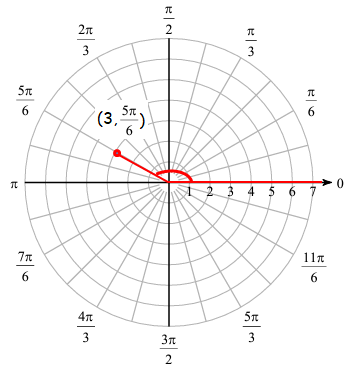
Second point :
By finding coterminal angle, we can get more points or we use the formula (r, θ + 2kπ). Here we apply k = -1.
= (3, ((5π/6) - 2π))
= (3, (5π - 12π/6))
= (3, (- 7π/6))
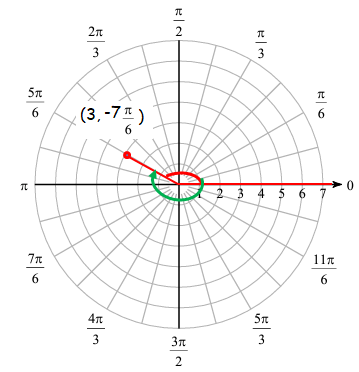
Third point :
Now we may do reflection to get the other point. If we use formula (-r, θ + (2k+1) π), then we apply k = 0 and change radius as negative.
= (-3, (5π/6)+ π)
= (-3, (5π + 6π)/6))
= (-3, (11π/6))
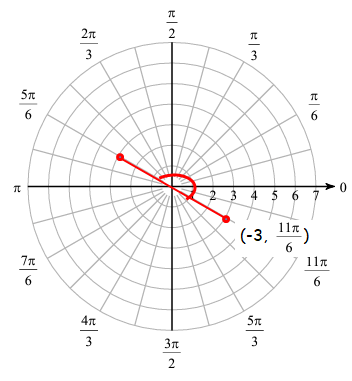
Fourth point :
Finding coterminal angle of 11π/6, we get
= (11π/6) - 2π
= (11π - 12π)/6
= -π/6
So, the three different representation of polar point (3, 5π/6) are
(3, (- 7π/6)), (-3, (11π/6)) and (-3, -π/6)
Note :
We can get infinitely many points.
Problem 2 :
(-4, π/12)
Solution :
Here r = -4 and θ = π/12.
First point :
(-4, π/12)
Second point :
Finding reference angle,
(-4, (π/12) - 2π))
(-4, -23π/12)
Third point :
Since the radius is negative, we can do the reflection
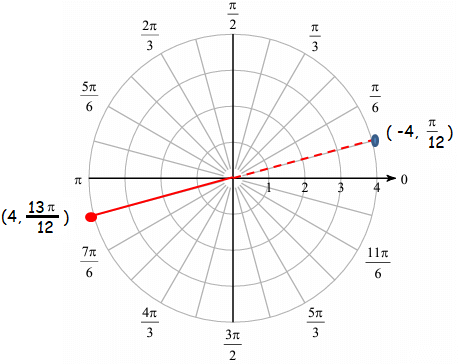
(4, 13π/12)
Fourth point :
By finding reference angle
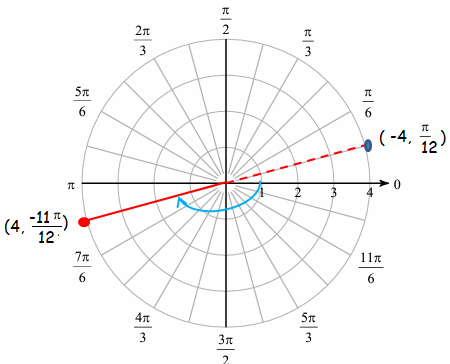
(4, -11π/12)
Other way using formula :
(r, θ + 2kπ) or (-r, θ + (2k+1) π)
Considering the given point as (r, θ) which is (-4, π/12)
(r, θ + 2kπ)
- When k = 0, then (4, π/12)
- When k = -1, then (4, (π/12) - 2π)) ==> (4, (-23π/12))
Changing sign of r, then the new point will be in the form
(-r, θ + (2k+1) π)
- When k = 0, then (-4, π/12 + π) ==> (-4, 13π/12)
- When k = -1, then (4, (π/12) - π)) ==> (4, (-11π/12))
So, the three different representation of the point (-4, π/12) are
(4, (-23π/12)), (-4, 13π/12) and (-4, (-11π/12))
Problem 3 :
(2, -3π/2)
Solution :
Here r = 2 and θ = -3π/2.
Given point :
(2, -3π/2)
Let us find the alternate point using formula,
(r, θ + 2kπ)
When k = 1
First point :
= (2, -3π/2 + 2π)
= (2, π/2)
Using the formula (-r, θ + (2k+1) π), we may find the other two points.
Second point :
When k = 0
= (-2, -3π/2 + π)
= (-2, π/2)
Third point :
When k = 1
= (-2, -3π/2 + 3π)
= (-2, 3π/2)
So, the three different representation of the point (2, -3π/2) are
(2, π/2), (-2, π/2), (-2, 3π/2)
Problem 4 :
(-4, -7π/6)
Solution :
Here r = -4 and θ = -7π/6
Given point :
(-4, -7π/6)
Let us find the alternate point using formula,
(r, θ + 2kπ)
When k = 1
First point :
= (-4, -7π/6 + 2π)
= (-4, 5π/2)
Using the formula (-r, θ + (2k+1) π), we may find the other two points.
Second point :
When k = 0
= (4, -7π/6 + π)
= (4, -π/6)
Third point :
When k = 1
= (4, -7π/6 + 3π)
= (4, 11π/6)
So, the three different representation of the point (-4, -7π/6)are
(-4, 5π/2), (4, -π/6) and (4, 11π/6)
Problem 5 :
(2, 23π/12)
Solution :
Here r = 2 and θ = 23π/12
Given point :
(2, 23π/12)
Let us find the alternate point using formula,
(r, θ + 2kπ)
When k = -1
First point :
= (2, 23π/12 - 2π)
= (2, -π/12)
Using the formula (-r, θ + (2k+1) π), we may find the other two points.
Second point :
When k = -1
= (-2, 23π/12 - π)
= (-2, 11π/12)
Third point :
When k = -2
= (-2, 23π/12 - 3π)
= (-2, -13π/12)
So, the three different representation of the point (2, 23π/12) are
(2, -π/12), (-2, 11π/12) and (-2, -13π/12)
Recent Articles
-
Finding Range of Values Inequality Problems
May 21, 24 08:51 PM
Finding Range of Values Inequality Problems -
Solving Two Step Inequality Word Problems
May 21, 24 08:51 AM
Solving Two Step Inequality Word Problems -
Exponential Function Context and Data Modeling
May 20, 24 10:45 PM
Exponential Function Context and Data Modeling